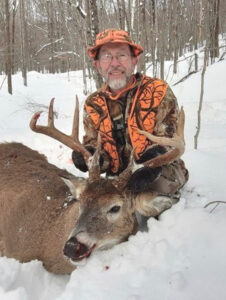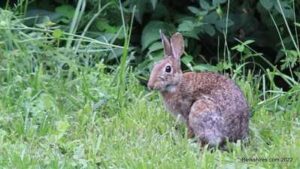Local author, Paul C. Carter of Dalton has come out with a new deer hunting book entitled, More Deer Hunts, through a Tracker’s Eyes. Paul is the author of several other hunting books including: Tracking Whitetails: Answers to your Questions; Great Shot! A Guide to Acquiring Shooting Skills for Big Game Hunters; Sheep Hunts: One Man’s Journeys to the High Country and Deer Hunts: Through a Tracker’s Eyes. I have always liked his writing and reviewed most of his books in this column. This last one is arguably his best.
It is a collection of recounted hunting stories like his book Deer Hunts: Through a Tracker’s Eyes,, but chosen for its entertainment value. It includes successful and unsuccessful hunts as well as humor.
In the beginning of the book, he spells it out. “Innate skill, in any venture, is never determinative for one’s final station in life. The wild card is effort: how much time and energy one is willing to dedicate to honing those natural gifts with which we have been blessed.” Paul has demonstrated that principle throughout the book.
“Tracking” he wrote “means being able to sneak up to a deer within shooting range.” “Independence, self-sufficiency, and proper mindset are hallmarks of every single tracker who has ever lived. Add to that patience and perseverance, and of course an overwhelming sense of satisfaction when successful. Good deer hunters are not born that way, they are made.”
He noted the importance of comrades and wrote stories involving them. Important ones in his life include his father Charles Carter, William Drew, and Albert Cady (all deceased) and Paul “John” Dupuis who is still with us. (Perhaps you knew these people and maybe hunted with them yourself). And, of course, his son Andrew.
He also discussed times when he and his son had tracked and shot deer in areas where they had no choice but to ask local residents if they could drag deer out of the woods onto their private properties. He mentioned Cindy and Martin Glendon of Windsor and how nice and helpful they were in locating where Paul had probably left his deer and then called fellow Windsor residents Kevin and Debbie Robitaille and secured permission for Paul and Andrew to access their land to drag it out.
I like his “boots on the ground” approach. It seems as though you are accompanying Paul on these hunts enduring 6 miles of tracking, sometimes in 18 inches of snow. At times his hunts are like mysteries as you travel with him defining the clues and discussing his tracking strategies to be used. It’s hard to put the book down until that mystery is solved with success or failure.
He did not take any actions or made any tracking decisions without thoroughly explaining and weighing the options. For example, he discussed ways to determine the gender of an unseen deer by other means than just the size and characteristics of the track. Now and then, you share his anguish in the possibility of being wrong (which was rare).
He discussed everything, even how a sudden shift in wind direction or a snapped twig could turn an opportunity to a disaster, something that experienced hunters know only too well. In his later years, (70’s) Paul still had the tenacity to hunt and track hard and cover miles of terrain. I liked how he mentioned one day hunting in the back of his house following a heavy snowstorm. If you knew where Paul lives, you’d know that he is not writing about a hayfield, but rather rugged terrain. Rugged terrain and winter conditions that local hunters also experience.
I liked how he put this: “A good tracker’s eyes penetrate brush, systematically, one branch at a time, in search of a small piece of your quarry’s body”.
In the final chapter of the book, Paul concludes, “I can only hope that my efforts to convey the true reasons for my bewitchment with tracking have been successful. If my words prompt some readers to take the plunge, then that’s all for the better. Potential new recruits aside, I pray I’ve adequately portrayed the essence of tracking deer, a subject both dear to my heart and worthy of wider appreciation”.
Well, you did, my friend, you did.
If you consider yourself a good deer tracker, you might want to pick up his book and compare strategies. You may learn a thing or two. (I did.) If you are contemplating taking up this method of deer hunting, you need to read this book.
The soft-covered book which is comprised of 276 pages, including many photos documenting deer kills, deer tracks and other deer signs, costs $20.00 and is available through Amazon. Alternatively, he always enjoys hearing from other hunters and he can sell his books personally. His email is: jpcarter384@verizon.net and phone number is (413) 684-0634.
Deer Management Program
At the upcoming October 6 meeting of the Berkshire County League of Sportsmen, Martin Freehan, MassWildlife Deer Project Leader, will be giving an overview of its Deer Management program. It will take place at 7:00 pm at the Cheshire Rod & Gun Club Clubhouse on 310 Curran Road, Cheshire. The public is welcome.
Beagle Club field trials
On October 8 & 9 the Jack Silvernale Memorial Field Trial will take place at the Berkshire Beagle Club, 380 Sleepy Hollow Road in Richmond. It will be a SPO sponsored trial on rabbits or hares. Entry fee is $22.00. The running order is: 13 and 15-inch males on October 8, and 13 and 15- inch females on the 9th. They will have a raffle for a Garmin Alpha Collar TT Mini as well as raffles of $500, $300 and $100 for Cabela’s gift cards. For more information contact Jeffery St John at (413)441-0744.
Active military and veteran waterfowl hunt
The special season opens on October 8. Check the waterfowl regulations for the details
Be aware of Rabbit Virus
With rabbit and hare hunting seasons approaching in Massachusetts (October 15), hunters should be aware of the following announcement from the VT Fish & Wildlife:
“Rabbit hemorrhagic disease virus, a highly contagious virus capable of affecting rabbits and snowshoe hares, is appearing in states close to Vermont and Massachusetts and may show up here according to the Vermont Fish and Wildlife Department.
There have been no cases in either state but Connecticut Department of Agriculture recently confirmed an outbreak in Hartford County that killed 14 domestic rabbits. The disease has also been found in New York State and New Jersey.
It is thought to be spreading eastward from the western United States. The virus does not affect other wildlife, humans or pets, except rabbits. It spreads through direct contact with infected rabbits or indirectly through contact with contaminated surfaces.
Sudden mortality in healthy rabbits occurs with this virus, and infected rabbits may be lethargic, reluctant to move, or have blood coming out of the nostrils or mouth.
The disease has caused die-offs in wild rabbits in Arizona, Colorado, New Mexico, Nevada, Texas and Utah beginning in 2020 and was first detected in domestic rabbits in New York that same year.
According to the U.S. Department of Agriculture, the virus is spread through exposure or contact with an infected rabbit’s excretions or blood. It can survive and spread from carcasses, food, water, and any contaminated materials and people can spread the virus indirectly by carrying it on their clothing and shoes.
There is no U.S. approved vaccine although Connecticut approved the sale of an unlicensed vaccine under emergency authorization last year.
The Massachusetts Department of Agricultural Resources recommends isolating pet and domestic rabbits from any possible contact with their wild cousins. Any new or returning rabbits to a colony should be quarantined for 14 days and watched closely; handlers should take sanitary precautions and use separate equipment to prevent any possible contamination between colonies.
When hunters are field-dressing rabbits, wear disposable gloves, securely bag entrails and other remains, and dispose of them in the trash. Do not discard remains where other animals may have access to them.
Fall Turkey Shoots
The Lenox Sportsmen’s Club and the Cheshire Rod & Gun Club are having their fall turkey shoots every Sunday until November 20 at their club houses. The Lenox Club starts at 12:30 pm and also has pie shoots. Cheshire shoots start at 1:00 pm


